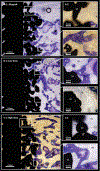Does tobramycin impregnation of allograft bone affect implant fixation? - an experimental study in 12 dogs
- PMID: 23897751
- PMCID: PMC6326084
- DOI: 10.1002/jbm.b.32993
Does tobramycin impregnation of allograft bone affect implant fixation? - an experimental study in 12 dogs
Abstract
Clinical trials have used antibiotic impregnated impacted bone allograft in revisions of infected arthroplasties. By this method high local antibiotic concentration and good control of infection was achieved. Toxicity studies, however, suggest that high local antibiotic concentration can impair osteoblast replication. We therefore asked whether impregnating morselized allograft bone with different quantities of tobramycin before impaction would impair implant fixation. We implanted three cylindrical (10 mm × 6 mm) porous-coated titanium implants into the distal femurs of 12 dogs. The implants were surrounded by a circumferential gap of 2.5 mm into which a standardized volume of morselized allograft bone, with or without tobramycin, was impacted. In each animal, the bone graft was impregnated with either 0 mg (control), 50 mg (low dose), or 200 mg (high dose) of tobramycin per 1 mL of bone graft. At the end of the 4 weeks experimental period, the implants with surrounding bone were evaluated by histomorphometric analysis and mechanical push-out test. We found no difference between the treatment groups regarding new bone formation, bone graft resorption, or implant fixation. There was, however, a tendency toward a decrease in implant fixation with higher tobramycin dose. The present study is unable to provide evidence on whether the use of topical tobramycin with allograft is safe or whether it indeed can impair implant fixation. The tendency toward an impaired implant fixation warrants further preclinical studies. Its current clinical use should be weighed against its possible positive effects on preventing infection in complicated revisions.
Keywords: implant fixation; impregnation; morselized allograft bone; osseointegration; tobramycin.
Copyright © 2013 Wiley Periodicals, Inc.
Figures




Similar articles
-
Bone allograft and implant fixation tested under influence of bio-burden reduction, periosteal augmentation and topical antibiotics. Animal experimental studies.Dan Med J. 2014 Jan;61(1):B4720. Dan Med J. 2014. PMID: 24393592 Clinical Trial.
-
Adjuvant therapies of bone graft around non-cemented experimental orthopedic implants stereological methods and experiments in dogs.Acta Orthop Suppl. 2008 Aug;79(330):1-43. Acta Orthop Suppl. 2008. PMID: 19065776 Review.
-
Soaking morselized allograft in bisphosphonate can impair implant fixation.Clin Orthop Relat Res. 2007 Oct;463:195-201. doi: 10.1097/BLO.0b013e31813c6696. Clin Orthop Relat Res. 2007. PMID: 17621234
-
The effect of soaking allograft in bisphosphonate: a pilot dose-response study.Clin Orthop Relat Res. 2010 Mar;468(3):867-74. doi: 10.1007/s11999-009-1099-9. Epub 2009 Sep 18. Clin Orthop Relat Res. 2010. PMID: 19763718 Free PMC article.
-
Strontium in the bone-implant interface.Dan Med Bull. 2011 May;58(5):B4286. Dan Med Bull. 2011. PMID: 21535993 Review.
Cited by
-
Lyophilized Human Bone Allograft as an Antibiotic Carrier: An In Vitro and In Vivo Study.Antibiotics (Basel). 2022 Jul 19;11(7):969. doi: 10.3390/antibiotics11070969. Antibiotics (Basel). 2022. PMID: 35884224 Free PMC article.
-
Evidence-Based Recommendations for Local Antimicrobial Strategies and Dead Space Management in Fracture-Related Infection.J Orthop Trauma. 2020 Jan;34(1):18-29. doi: 10.1097/BOT.0000000000001615. J Orthop Trauma. 2020. PMID: 31464858 Free PMC article. Review.
-
Increased release time of antibiotics from bone allografts through a novel biodegradable coating.Biomed Res Int. 2014;2014:459867. doi: 10.1155/2014/459867. Epub 2014 Jun 19. Biomed Res Int. 2014. PMID: 25045678 Free PMC article.
-
Lyophilized allogeneic bone tissue as an antibiotic carrier.Cell Tissue Bank. 2016 Dec;17(4):629-642. doi: 10.1007/s10561-016-9582-5. Epub 2016 Sep 8. Cell Tissue Bank. 2016. PMID: 27631323 Free PMC article.
-
[Potential of allogeneic bone grafts as antibiotic carriers : Effect of different preparation processes on efficacy].Orthopade. 2018 Jan;47(1):30-38. doi: 10.1007/s00132-017-3507-2. Orthopade. 2018. PMID: 29230489 Review. German.
References
-
- Overgaard S Danish Hip Arthroplasty Registry Annual Report 2011. 2011; Available from: http://www.dhr.dk/Ny%20mappe/rapporter/DHR%20årsrapport%202012%20final-2.... Danish.
-
- Gie GA, Linder L, Ling RS, Simon JP, Slooff TJ, Timperley AJ. Impacted cancellous allografts and cement for revision total hip arthroplasty. J Bone Joint Surg Br. 1993;75(1):14–21. - PubMed
-
- Burchardt H The biology of bone graft repair. Clin Orthop RelatRes 1983; (174):28–42. - PubMed
-
- Schreurs BW, Slooff TJ, Buma P, Gardeniers JW, Huiskes R.Acetabular reconstruction with impacted morsellised cancellous bone graft and cement. A 10- to 15-year follow-up of 60 revision arthroplasties. J Bone Joint Surg Br 1998;80(3):391–395. - PubMed
-
- Toms AD, Barker RL, Jones RS, Kuiper JH. Impaction bone-grafting in revision joint replacement surgery. J Bone Joint Surg Am 2004;86–A(9):2050–2060. - PubMed
Publication types
MeSH terms
Substances
Grants and funding
LinkOut - more resources
Full Text Sources
Other Literature Sources
Medical
Miscellaneous

